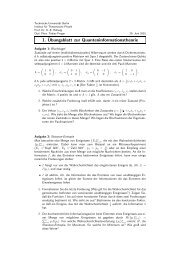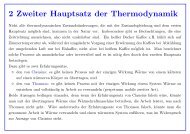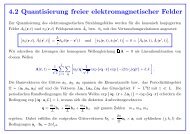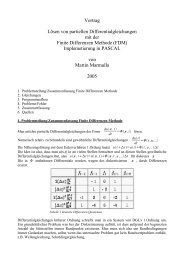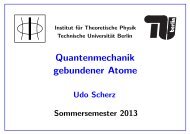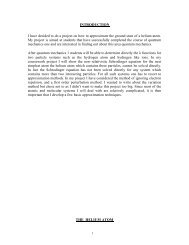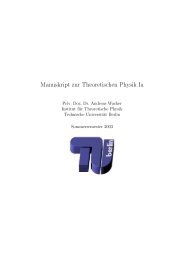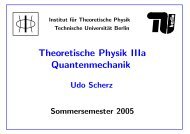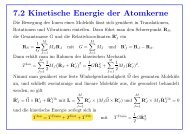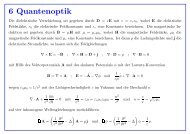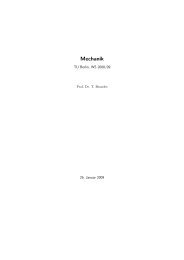1.1 The Radiation Laws and the Birth of Quantum Mechanics
1.1 The Radiation Laws and the Birth of Quantum Mechanics
1.1 The Radiation Laws and the Birth of Quantum Mechanics
You also want an ePaper? Increase the reach of your titles
YUMPU automatically turns print PDFs into web optimized ePapers that Google loves.
QUANTUM MECHANICS I (Dr. T. Br<strong>and</strong>es): Example/Solution Sheets 17<br />
3.11.3 * Expansion into eigenmodes (40 min)<br />
Consider <strong>the</strong> vector f ∈ H, f(x) = cx(L − x).<br />
a) Calculate <strong>the</strong> constant c such that f is normalized, i.e. ‖f‖ = 1. Show that c = √ 30/L/L 2 .<br />
∫ L<br />
∫ L<br />
1 = ‖f‖ 2 = dxf ∗ (x)f(x) = c 2 x 2 (L − x) 2 =<br />
0<br />
0<br />
∫ L<br />
[ 1<br />
= c 2 dx[x 4 − 2Lx 3 + L 2 x 2 ] = c 2 L 5 5 − 2 4 + 1 ] √<br />
30<br />
c =<br />
3<br />
L<br />
0<br />
b) Show that f can be exp<strong>and</strong>ed in <strong>the</strong> basis ψ n as<br />
1<br />
L 2 .<br />
∞∑<br />
f = c n ψ n ,<br />
n=1<br />
c n = 2 √ 60 1 − (−1)n<br />
n 3 π 3 (3.90)<br />
We have<br />
√<br />
2<br />
c n = 〈ψ n |f〉 = c<br />
L<br />
= √ 60<br />
∫ 1<br />
0<br />
∫ 1<br />
∫ 1<br />
c) Use b) to prove <strong>the</strong> formula<br />
We have<br />
√<br />
30<br />
L<br />
0<br />
0<br />
∫ L<br />
0<br />
dxx(L − x) sin<br />
dy(y − y 2 ) sin(nπy).<br />
dyy sin(nπy) = − cos(nπ)<br />
nπ<br />
dyy 2 sin(nπy) = − 2<br />
n 3 π 3 + 2 − n2 π 2<br />
n 3 π 3<br />
1<br />
L 2 x(L − x) = √ 60<br />
(1/2)(1/4) =<br />
π3<br />
32<br />
=<br />
∞∑<br />
n=1<br />
∞∑<br />
k=0<br />
3.11.4 * Scalar product (20 min)<br />
<br />
∞∑<br />
n=1<br />
∫ 1<br />
0<br />
( nπx<br />
)<br />
= [y = x/L) =<br />
L<br />
cos(nπ)<br />
dy(y − y 2 ) sin(nπy) = 2 1 − (−1)n<br />
n 3 π 3<br />
π 3 ∞<br />
32 = ∑ (−1) k<br />
(2k + 1) . 3<br />
k=0<br />
2 1 − (−1)n<br />
n 3 π 3<br />
2 1 − (−1)n<br />
n 3 π 3<br />
(−1) k<br />
(2k + 1) 3 .<br />
sin<br />
√<br />
2<br />
( nπx<br />
)<br />
L sin , setx = L/2<br />
L<br />
∞∑<br />
( nπ<br />
)<br />
= [n = 2k + 1] =<br />
2<br />
k=0<br />
4(−1) k<br />
π 3 (2k + 1) 3<br />
a) Use <strong>the</strong> bra <strong>and</strong> ket notation to show that for an orthonormal basis {|ψ n 〉} <strong>and</strong> two Hilbert<br />
space vectors |ψ〉 <strong>and</strong> |χ〉, one has<br />
〈ψ|χ〉 =<br />
∞∑<br />
〈ψ|ψ n 〉〈ψ n |χ〉. (3.91)<br />
n=0




